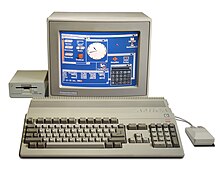
Back Amiga ALS أميغا Arabic اميجا ARZ Amiga Bulgarian Amiga Breton Amiga Catalan Amiga Czech Commodore Amiga Danish Amiga German Commodore Amiga Greek
 | |
 The 1987 Amiga 500 was the bestselling model. | |
| Manufacturer | Commodore International (until 1994) Escom AG (1995–1996) QuikPak (–c. 1998) |
|---|---|
| Type | Personal computers Game console (CD32) |
| Release date | July 23, 1985 |
| Discontinued | 1996[a] |
| Units sold | approx. 4.91 million[1] |
| Operating system | AmigaOS on Kickstart |
| Predecessor | |
Amiga is a family of personal computers produced by Commodore from 1985 until the company's bankruptcy in 1994, with production by others afterward. The original model is one of a number of mid-1980s computers with 16-bit or 16/32-bit processors, 256 KB or more of RAM, mouse-based GUIs, and significantly improved graphics and audio compared to previous 8-bit systems. These include the Atari ST—released earlier the same year—as well as the Macintosh and Acorn Archimedes. The Amiga differs from its contemporaries through custom hardware to accelerate graphics and sound, including sprites, a blitter, and four channels of sample-based audio. It runs a pre-emptive multitasking operating system called AmigaOS.
The Amiga 1000, based on the Motorola 68000 microprocessor, was released in July 1985. Production problems kept it from becoming widely available until early 1986.[2] While early advertisements cast the computer as an all-purpose business machine,[3] especially with the Sidecar IBM PC compatibility add-on, the Amiga was most commercially successful as a home computer with a range of video games and creative software. The bestselling model, the Amiga 500, was introduced in 1987 along with the more expandable Amiga 2000. The 1990 Amiga 3000 includes a minor update to the graphics hardware via the Enhanced Chip Set, also used in subsequent models.
The Amiga established a niche in audio and multimedia. The first music tracker was written for the Amiga, and it became a popular platform music creation. The 3D rendering packages LightWave 3D, Imagine, and Traces (a predecessor to Blender) originated on the system. The 1990 third-party Video Toaster made the Amiga a comparatively low cost option for video production. In later years, the Amiga started losing market share to IBM PC compatibles and video game consoles, eventually leading to Commodore's bankruptcy in 1994 and then the end of Amiga. Commodore is estimated to have sold an 4.85 million Amigas. Various groups have since released spiritual successors.
Cite error: There are <ref group=lower-alpha> tags or {{efn}} templates on this page, but the references will not show without a {{reflist|group=lower-alpha}} template or {{notelist}} template (see the help page).
- ^ "Nobody Knows How Many Amigas Commodore Sold". YouTube. 30 August 2024.
- ^ Classic Videogame Hardware Genius Guide. Imagine Publishing. 2012. p. 171. ISBN 9781908222220.
- ^ Cite error: The named reference
ad1987bwas invoked but never defined (see the help page).